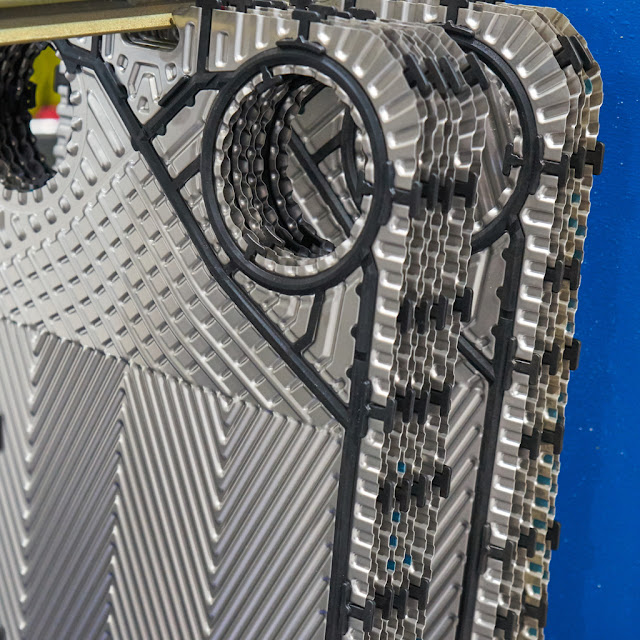I realized that talking about questions on Plate Heat Exchangers could be a very long story... Now let's go ahead on Part 3.
(Q) On Data sheet is mentioned AHRI Certified. What does it mean?
(A) The AHRI Product Performance Certification Program is a voluntary program, administered and governed by AHRI, which ensures that various types of heating, ventilation, air conditioning, refrigeration, and water heating products perform according to manufacturers’ published claims. Products that are certified through the AHRI Product Performance Certification Program are continuously tested, at the direction of AHRI, by an independent third–party laboratory, contracted by AHRI, to determine the product’s ability to conform to one or more product rating standards or specifications.
This program applies to Production Models of Gasketed Plate-Type Heat Exchangers, that utilizes any of the following fluids on one or both circuits, for HVAC applications only.
- Water;
- Seawater;
- Ethylene Glycol (10%-50% concentration);
- Propylene Glycol (10%-50% concentration)
(Q) Our Maintenance Dept. trying to solve problerm due to leakage, was tightening plate pack too much, less than "A" measure in nameplate, so that plates are deformed. There are any chance to reshape plate on original pattern?
(A) Generally once plate has lost original corrugation design it is no worth trying to get back to previous shape, it is better to buy a new plate pack.
Just in case of large size plate in exotic material trying to adjust existing plate makes sense, bearing in mind that in any case positive results are not guaranteed.
(Q) Several PHE Manufacturers are mentioning clip-on, Clip-Grip gaskets, Sonderlock, Eco-Loc glueless gaskets. Which are advantages?
(A) In recent years glueless gaskets has been introduced, mainly in HVAC market later on on industrial application. First of all we have to consider that glue function is to keep gasket in right position on gasket groove of plate and NOT to seal fluids.
Glue is never in contact with process fluids. Take away glue from gasket it not easy (sometimes nitrogen at low temperature was used to get brittle material of gasket for easy removal),
In the field is rather common to heat up backside of the plate with burning flame to remove gasket or in Service Centre a solution of caustic soda at 20% at 60 °C followed after water rinsing with ortophoshopric acid at same condition is best way.

In the past main issue was on large size plates, because once opened plate plack, gaskets were sticky to back side of adiacent plate and often after efforts collapsing on the earth. For this reason EPC Contractors and top players on Oil & Gas were keeping glue gaskets in their projects.
Recently, with new development on fixing system of gaskets on plate like Clip-Grip gluless gasket are widely accepted.
(Q) We found small traces of process fluid in cooling water, but looking at plates we are not able to detect any hole. What shall we do?
(A) In case of chloride presence higher that 300 ppm corrosion could be possible (pitting) with 304/316 steel as plate material, difficult to detect (small holes)
Only alternative to inspect for corrosion, holes or cracks is dye penetrant testing. Using this method, which originated in the aviation industry, even the finest hairline cracks in the plate can be made visible.
After cleaning, the entire surface of each single plate is sprayed with a fluorescent paint. After the appropriate exposure time, the plate is rotated and thoroughly inspected under UV light in the darkened test room. Damaged plates are marked accordingly and sorted out. Flawless plates are now cleaned again by means of high pressure.
The ultraviolet test is used upon request, usually specialty applications where fluid mediums can only detected under UV light.
On site Dye-Testing is standard for locating cracks, pinholes, or failures. With red dye-penetrant saturating the plate surface, and white developer solution covering the reverse side, test is capable of detecting even miniscule imperfections

(Q) On data sheet is mentioned over-thichkness for corrosion 3 mm. How can apply to a plate of 0.5 mm?
(A) This is a result of copy & paste of a Shell & Tube in Carbon Steel specification.
Over thickness on stainless steel is a nonsense in standard indusrtrial application.
Only typical case in PHE is on Sulphuric Acid where HastelloyC 276 plates are used with 0.7 mm instead of 0.6 mm taking in consideration corrosion rate of material every year.
Plate heat exchangers constructed of alloy C-276 plates and Viton gaskets impose certain limitations on the process in order to achieve reliable and extended operation of the heat exchangers. The maximum allowable temperature into a plate heat exchanger is a function of acid concentration. Exceeding the maximum temperature will result in higher corrosion rates and reduced life of the plate pack. Concentration Maximum Temperature Expected
Corrosion Rate
98% 90°C (200°F) < 0.08 mm/year
92% 70°C (160°F) -
70% 60°C (120°F) -
(Q) Can I use PHE with air?
(A) Brazed units are suitable for these applications As a refrigerated air dryer, BPHE units separate humidity from compressed air by cooling the air in an evaporator. As the air cools and loses its ability to hold moisture, the condensate exits through a separator.
(continue)











Commenti
Posta un commento